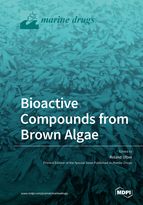Bioactive Compounds from Brown Algae
A special issue of Marine Drugs (ISSN 1660-3397).
Deadline for manuscript submissions: closed (25 June 2021) | Viewed by 40014
Special Issue Editor
Interests: white (industrial) and marine biotechnology; biocatalysis; the development of downstream processes
Special Issues, Collections and Topics in MDPI journals
Special Issue Information
Dear Colleagues,
Brown algae comprise approx. 2040 species grown in various climatic conditions. They represent a reservoir of various bioactive compounds, including fucoidan, alginate, phlorotannins, and fucoxanthins. They have shown an array of applications in pharmaceutical and medical fields. Hence, the Guest Editor invites all interested authors to submit their contributions to the current issue in Marine Drugs entitled “Bioactive Compounds from Brown Algae”. It aims to highlight different aspects of bioactive compounds found in brown algae, in either research or review articles. Specifically, we are interested in downstream processes, chemistry, biotechnology, and applications of, for example, heteropolysaccharides and other brown algae bioactives. In addition, the structure elucidation and enzymatic modification of these components are also within the scope of the present Issue.
Prof. Dr. Roland Ulber
Guest Editor
Manuscript Submission Information
Manuscripts should be submitted online at www.mdpi.com by registering and logging in to this website. Once you are registered, click here to go to the submission form. Manuscripts can be submitted until the deadline. All submissions that pass pre-check are peer-reviewed. Accepted papers will be published continuously in the journal (as soon as accepted) and will be listed together on the special issue website. Research articles, review articles as well as short communications are invited. For planned papers, a title and short abstract (about 100 words) can be sent to the Editorial Office for announcement on this website.
Submitted manuscripts should not have been published previously, nor be under consideration for publication elsewhere (except conference proceedings papers). All manuscripts are thoroughly refereed through a single-blind peer-review process. A guide for authors and other relevant information for submission of manuscripts is available on the Instructions for Authors page. Marine Drugs is an international peer-reviewed open access monthly journal published by MDPI.
Please visit the Instructions for Authors page before submitting a manuscript. The Article Processing Charge (APC) for publication in this open access journal is 2900 CHF (Swiss Francs). Submitted papers should be well formatted and use good English. Authors may use MDPI's English editing service prior to publication or during author revisions.
Keywords
- Brown algae
- Heteropolysaccharides
- Fucoidan
- Bioactives
- Cultivation
- Chemistry
- Metabolomics
- Biotechnology
- Bioengineering
- Nanomedicine
- Phlorotannins
- Alginates
- Downstream processes
- Pharmacology of brown algae metabolite
- Recent applications
- Structure-activity relationships







